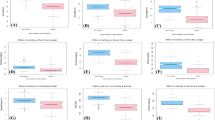Summary
The responses of 400 Iranian tetraploid and hexaploid landrace wheat accessions to variation in soil salinity were investigated at a field site in the San Joaquin Valley of California, U.S.A. The salinity treatments were represented by soil conductivity values (EC e ,) of 1.0 (control), 5.0, and 8.0 dS m−1 and were maintained by irrigation with water of similar or slighly higher conductivity. A subset of 200 hexaploid accessions was analyzed from the first year of study. For the second year, 77 accessions were selected as having high, low, or random salinity tolerance based on the Fischer-Mauer stress index (S) estimated in the first year. In both years the accessions and three check varieties were evaluated in hill-plots. The interyear correlations for S were very low in contrast to grain yield whereas the correlations at the same salinity level between years were significant: 0.42, 0.46, and 0.44, respectively, for control, intermediate, and high salinity. High grain yield under salinity stress appeared to be a better selection criterion for salinity tolerance than biomass yield, harvest index, orS. Analysis of accessions from 12 Iranian provinces from which five or more accessions originated gave evidence for geographic differentiation for characters related to salinity tolerance. Several accessions, differing in geographical origin within Iran, were shown to be consistently high ranking for grain yield in the control and two salinity treatments.
Similar content being viewed by others

References
Benedetelli, S., C. Tomassini, D. Lafiandra, A. B. Damania & E. Porceddu, 1988. Variation in morphophysiological characters in landrace populations of wheat from Nepal. Proc. Int. Symp. on Problems and Prospects of Winter Cereals and Food Legumes Production in High Elevation Areas of West Asia, Southeast Asia, and North Africa. Ankara, Turkey, 1987. p. 292–302. ICARDA. Aleppo, Syria.
Blum, A., G. Golan, J. Mayer, B. Sinmena, L. Shpiler & J. Burra, 1989. The drought response of landraces of wheat from the northern Negev Desert in Israel. Euphytica 43: 87–96.
Damania, A. B., M. T. Jackson & E. Porceddu, 1985. Variation in wheat and barley landraces from Nepal and the Yemen Arab Republic. Z. Pflanzenzühtg. 94: 13–24.
Ehdaie, B. & J. G. Waines, 1989. Genetic variation, heritability and path-analysis in landraces of bread wheat from southwestern Iran. Euphytica 4l: 183–190.
Ehdaie, B., J. G. Waines & A. E. Hall, 1988. Differential responses of landrace and improved wheat genotypes to stress environments. Crop Science 28: 838–842.
Epstein, E., 1963. Selective ion transport in plants and its genetic control. Proc. Desalination Res. Conf. NAS-NRC Public. 942: 284–298. National Acad. Press, Washington, D.C.
Epstein, E., J. D. Norlyn, D. W. Rush, R. W. Kingsbury, D. B. Kelly, G. A. Cunningham & A. F. Wrona, 1980. Saline culture of crops: a genetic approach. Science 210: 399–404.
Fischer, R. A. & R. Maurer, 1978. Drought resistance in spring wheat cultivars: I. Grain yield responses. Aust. J. Agric. Res. 29:897–912.
Hanson, B. R., W. Bowers, S. R. Grattan, D. W. Grimes & K. R. Tanji, 1991. Trace elements limit potential for blending San Joaquin drainwater with canal water. Calif. Agric. 45(2): 17–19.
Jones, R. A. & C. O. Qualset, 1984. Breeding crops for environmental stress tolerance. In: G. B. Collins & J. F. Petolino (Eds.)Applications of Genetic Engineering to Crop Improvement, pp. 305–340. Nijhoff/Junk, The Netherlands.
Kelman, W. & C. O. Qualset, 1991. Breeding for salinity-stressed environments: recombinant inbred wheat lines under saline irrigation. Crop Science 31: 1436–1442.
Kingsbury, R. W. & E. Epstein, 1984. Selection for salt-resistant spring wheat. Crop Science 24: 310–315.
Lyon, C. B., 1941. Responses of two species of tomatoes and Ft generation to sodium sulfate in the nutrient medium. Bot. Gaz. 103:107–122.
Munro, D., 1988. Chambers World Gazetteer. 5th edition. Chambers & Cambridge University Press.
Qualset, C. O. & H. Corke, 1991. Plant breeding to develop varieties for crop production with alternating saline and nonsaline irrigation: A case study of wheat in California. In: Plant Salinity Research Ed. Choukr-Allah, R., Proc. Int. Conf. on Agric. Management of Salt-Affected Areas. Agadir, Morocco, pp.137–147.
Richards, R. A., C. W. Dennett, C. O. Qualset, E. Epstein, J. Norlyn & M. D. Winslow, 1987. Variation in yield of grain and biomass in wheat, barley, and triticale in a salt-affected field. Field Crops Research 15: 277–287.
Sayed, H. I., 1985. Diversity of salt tolerance in a germplasm collection of wheat (Triticum spp.). Theor. Appl. Genet. 69: 651–657.
Shannon, M. C., 1978. Testing salt tolerance variability among tall wheatgrass lines. Agron. J. 70: 719–722.
Tesfaye, T., B. Getachew & M. Worede, 1991. Morphological diversity in tetraploid wheat landrace populations from the central highlands of Ethiopia. Hereditas 114: 171–176.
Author information
Authors and Affiliations
Rights and permissions
About this article
Cite this article
Jafari-Shabestari, J., Corke, H. & Qualset, C.O. Field evaluation of tolerance to salinity stress in Iranian hexaploid wheat landrace accessions. Genet Resour Crop Evol 42, 147–156 (1995). https://doi.org/10.1007/BF02539518
Received:
Accepted:
Issue Date:
DOI: https://doi.org/10.1007/BF02539518



